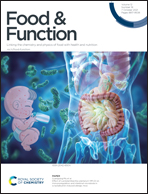Metabolomics analysis of time-series human small intestine lumen samples collected in vivo†
Abstract
The human small intestine remains an elusive organ to study due to the difficulty of retrieving samples in a non-invasive manner. Stool samples as a surrogate do not reflect events in the upper gut intestinal tract. As proof of concept, this study investigates time-series samples collected from the upper gastrointestinal tract of a single healthy subject. Samples were retrieved using a small diameter tube that collected samples in the stomach and duodenum as the tube progressed to the jejunum, and then remained positioned in the jejunum during the final 8.5 hours of the testing period. Lipidomics and metabolomics liquid chromatography tandem mass spectrometry (LC-MS/MS) assays were employed to annotate 828 unique metabolites using accurate mass with retention time and/or tandem MS library matches. Annotated metabolites were clustered based on correlation to reveal sets of biologically related metabolites. Typical clusters included bile metabolites, food metabolites, protein breakdown products, and endogenous lipids. Acylcarnitines and phospholipids were clustered with known human bile components supporting their presence in human bile, in addition to novel human bile compounds 4-hydroxyhippuric acid, N-acetylglucosaminoasparagine and 3-methoxy-4-hydroxyphenylglycol sulfate. Food metabolites were observed passing through the small intestine after meals. Acetaminophen and its human phase II metabolism products appeared for hours after the initial drug treatment, due to excretion back into the gastrointestinal tract after initial absorption. This exploratory study revealed novel trends in timing and chemical composition of the human jejunum under standard living conditions.



 Please wait while we load your content...
Please wait while we load your content...
